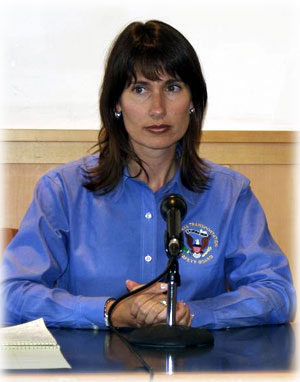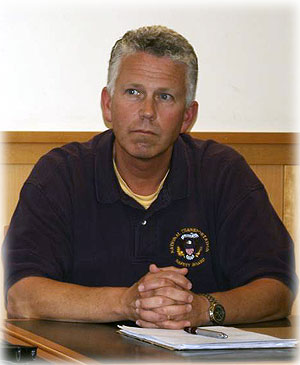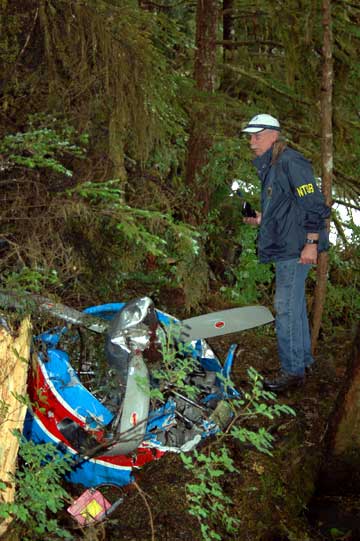 By M.C. Kauffman August 20, 2007
A sightseeing floatplane registered to SeaWind Aviation was returning from a bear-watching expedition Thursday evening when the plane crashed after takeoff around 6 pm in Traitor's Cove killing five of the nine people aboard. The four survivors were medivaced to Seattle. Traitor's Cove is approximately 27 miles north of Ketchikan. The De Havilland Beaver N345KA was manufactured in 1959. NTSB Board Member Debbie Hersman from Washington, D.C., said Saturday, "This is now considered a major accident." She said many of the NTSB investigations in Alaska are handled as regional accidents; however, with Thursday's crash being the second fatal air craft accident in Ketchikan in the last three weeks a decision was made to send a NTSB team of specialists in to look closely at this accident. Hersman said, "This is not uncommon. The NTSB has done this in the past." There were nine people onboard the ill-fated flight. Five fatalities were reported by the Alaska State Troopers, and there were four survivors At a Seattle hospital, 3-year-old Allison N. Smith remained in critical condition Saturday. Allison's twin brother died in the crash. Her grandmother, Mindy Mayer, 60, of Oregon City, was upgraded from serious to satisfactory condition. Mindy Mayer's son, Eric M. Smith, 37, his wife, Christine L. Smith, 36, and their 3-year-old son, Trevor, all of Tualatin, Oregon were killed in the Thursday evening crash. So was Mayer's husband, David R. Mayer, 60. California resident Daniel J. Herron, 49, also was killed. The pilot, Clifford S. Kamm, and tour guide, Sara J. Steffen, 27, were listed in satisfactory condition Saturday at Harborview Medical Center in Seattle. Hersman said the NTSB was notified shortly after the accident and two investigators were launched from the regional office in Anchorage, Alaska as well as a team of investigators from the Washington, DC office. Hersman said they all arrived in Ketchikan Friday. Hersman said at a Sunday press conference that it was a thirty to forty-five minute hike for the federal investigators just get through the brush to get to the accident scene Friday. She said it was a challenge for the NTSB team members. Hersman said, "I have a great deal of respect for the people who made it out and the rescuers who made it in to assist and help. It was very challenging and the community really came together." She said, "You could see the immediate response and the interest and the commitment of everyone who was able to go in and help." Hersman said, "We were able to locate fairly easily [Friday] the four corners of the airplane - the two wings, the nose and the tail." She said it is a concentrated debris field. It's about a hundred feet basically from the initial impact - the start of the wreckage to where the airplane came to rest. It's approximately 50 feet from the shoreline in a heavily wooded area. Hersman said some of the parts of the aircraft were in the water. However it was a different scene at low tide. Hersman said, " The parts that we saw that were in the water, near the water were the wing tips, horizontal stabilizer." 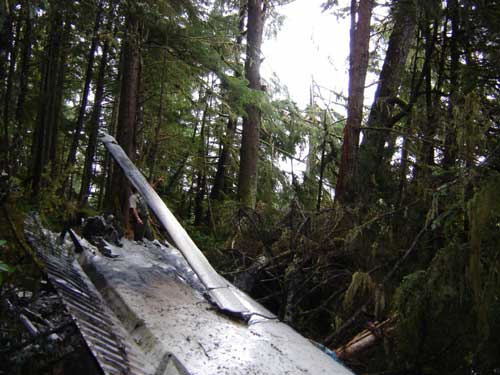 Hersman said, "Immediately in the vicinity, the primary tree strike and the damage to the trees is approximately 40 to 60 feet in elevation." She said, "We can identify visible impact. There is a broken tree, a large tree maybe up to 18 inches in diameter that has been broken." "The right wing is really pretty much at the base of that tree where we see the initial tree strike," said Hersman. The wing is completely detached from the fuselage, she said. The fuselage was approximately 50 feet from the right wing. The NTSB team looked at the three-bladed propeller and could see some signs of power. Hersman said one of the blades had a broken tip and other blades evidenced curling and torsional deformation. "We're still going to have to do some tests and some evaluations when we move it," said Hersman, "but those were some initial observations." She said once the aircraft is moved they will attempt to reconstruct it and establish control and surface continuity. "We'd also like to see if we can establish what the flap settings were but given the amount of impact and thermal damage, it appears that it's going to be very very difficult for us to establish some of those settings and information we would like to have." 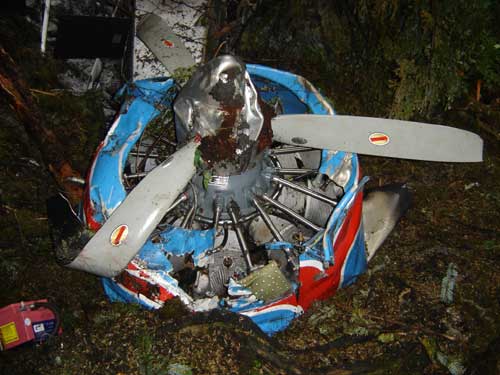
Hersman said there are parts of the aircraft that were not damaged by the fire at all. She said the right wing and the horizontal stabilizer that came off first had no thermal damage. There's impact damage but no thermal damage. Parts of the tail did not exhibit thermal damage. Hersman said the team does not yet have information about how the survivors got out of the plane. She said the investigators will be interviewing the survivors and the rescuers and people in the immediate vicinity. The Survival Factors Specialist is also looking at the terrain in the area. Hersman said the specialist commented that the terrain is very challenging. Hersman said, "It's quite amazing that the people who did survive were able to get out and be evacuated from the area." Of the terrain, Hersman said, "It's steep, slippery, rocky, wet and trying to get in and out of there is quite a challenge." 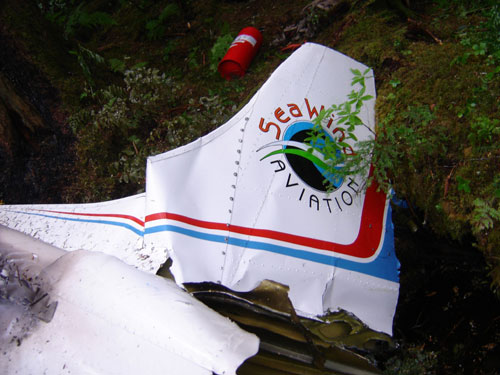
Hersman said, "The post impact fire was significant. There is extreme thermal damage to the cabin area of the aircraft." Clinton O. Johnson from Anchorage the NTSB Investigator in Charge has finished some of the on-scene documentation the NTSB team needs. Johnson has released the aircraft to be moved to a facility for storage. Hersman said once the aircraft is moved to a protected area they will try to put the aircraft back together as much as possible. "Basically finding all of the pieces and laying them out to see what we can learn from the aircraft," said Hersman. Moving the aircraft will be challenging. The plan is to remove the parts using a helicopter and barge the plane in to Ketchikan for storage. That plan could change. 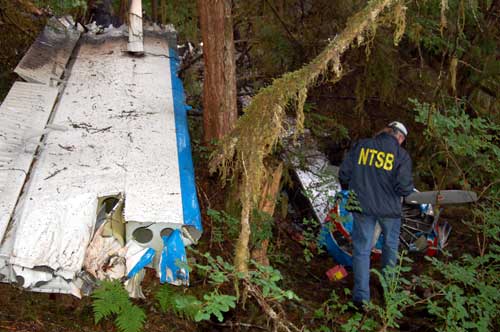 Sledzik is from the Anchorage office. Photo courtesy National Transportation Safety Board
According to information released by the federal investigators Sunday, pilot Clifford S. Kamm's last medical examination was conducted on March 8, 2007, Hersman said Kamm had a second class medical which was valid for one year. His ratings included a multi-engine land, multi-engine sea, single engine land and single engine sea. From his medical records it appeared that Kamm had 16,000 hours of flight time.
Hersman said they have heard many reports about weather activity at the time of the accident in Ketchikan and closer to the area of the accident. She said, "We're looking very closely at the weather." Radar information and satellite date are being collected and reported weather, winds at Ketchikan Airport as well as National Weather Service information. She said the team's Meteorologist will also be going out to the scene to look at the topography in the area and anything that might be specific to the immediate environment and also looking at pilot reports about the weather. Hersman said they will be on scene for several days and the team will continue to provide information to the public as they conduct the investigation. At some point, some of the investigators will move to Seattle to interview the survivors. She said it will be important for the NTSB team to talk with the survivors as they will be able to provide the investigators some of the best information. Hersman said, "Due to their medical conditions, we have not had an opportunity to interview them at this point in time." In a prepared statement released Friday Jack Davies said, "SeaWind Aviation's first concern is the care of the survivors and next of kin. We would like to express our deepest sympathy to the loved ones and all involved in this incident. At this time we are doing everything we can to assist the survivors and next of kin." He said, "We would also like to extend our heartfelt thanks to all of those involved in the response to this occurrence." Davies said, "This accident is under investigation by the authorities to determine its cause. We are not authorized to release any further information at this time." On behalf of the NTSB, Hersman also expressed condolences to the loved ones of the victims of Thursday's accident. "In addition we'd like to send out our wishes for a speedy recovery to all those who remain hospitalize," she said. A preliminary report is expected to be released by the NTSB in approximately ten days. The completion of the final report with the determination of the cause of the crash can be expected in approximately a year according to the investigators. Publish A Letter in SitNews Read Letters/Opinions
|
|||
